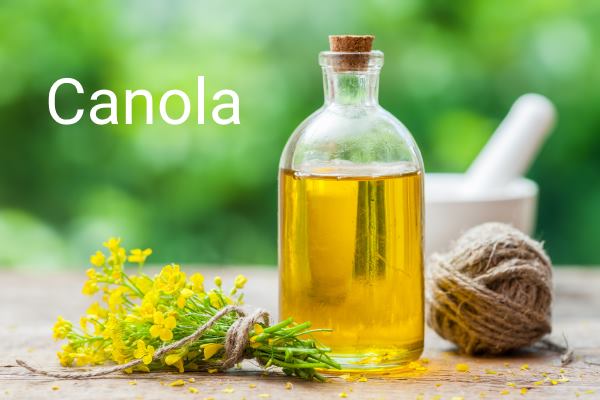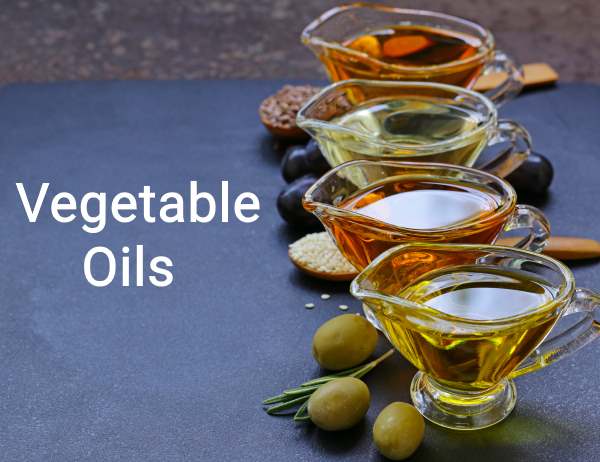What’s The Difference Between Canola Oil And Vegetable Oil?
Canola oil is made specifically from the seeds of the canola plant, while vegetable oil can be made from a variety of plants. In the kitchen, canola oil and vegetable oil will serve well in both hot and cool applications.
The have a similar smoke point at about 400 degrees Fahrenheit / 204 degrees Celsius, although vegetable oil may take a bit more heat over time.
In cool applications, such as salad dressings, it’s important to note that canola oil has a more consistent flavor and is quite mild, making it a good base for your favorite vinegars or citrus additions.
You’ll want to taste-test your vegetable oil of choice to confirm the flavor will work for your chosen dressing before you blend it.
Canola Oil

Where Does Canola Oil Come From?
The canola plant was developed in Canada in the 1960’s. This plant is a hybridization of the rapeseed plant. It should be noted that there is some confusion on this – you may find claims that canola oil is rapeseed oil, which is incorrect.
Rapeseed oil is dangerously high in erucic acid, a product that causes fat to build up in the heart and liver.
What Is Canola Oil Made From?
Canola oil is made from a modified rapeseed plant. Canadian researchers bred the canola plant from a rapeseed plant by reducing the level of erucic acid found in rapeseeds.
For a plant to be considered a canola plant, the seeds in the pods must contain fewer than 2% erucic acid.
Erucic acid is a fatty compound that can lead to myocardial lipidosis in livestock that are fed rapeseeds. In addition to fat build-up in the heart, consumption of rapeseed oil can add fat to the liver. This product is banned for human consumption.
Is Canola Oil Vegetable Oil?
Canola oil is made from the seeds of the canola plant, so technically it is a vegetable oil. However, because vegetable oils can be made from a variety of plant products, including soy, cooks should be aware that vegetable oils can produce a wider variety of flavors than canola oil.
Can You Use Canola Oil Instead Of Vegetable Oil?
Canola oil and vegetable oil have similar smoke points. At around 400 degrees Fahrenheit / 204 degrees Celsius, both canola and vegetable oil will burn. This will cause a sharp, bitter flavor and may add a lot of unwanted smoke to your home.
When making dressings, be aware that canola oil has a much more consistent flavor, as it’s not a blend of oils from many plant sources.
Is Canola Oil Better Than Vegetable Oil? How Is It Used?
Both have a similar smoke point and can be used for frying. Canola oil is consistently a good source of omega-3 and omega-6 fatty acids, critical to heart health. Canola oil is often used for dressings due to the neutral flavor of the oil.
SEE ALSO: Best Oil For Deep Frying
Vegetable Oil

What Is Vegetable Oil Made From?
Vegetable oil can be made from almost any plant product. Soybean oil and palm oil are commonly used in the production of vegetable oils in North America. However, you can also find vegetable oils that contain sunflower oil or cottonseed oil.
How Is Vegetable Oil Made?
Vegetable oil is made by compressing the seed stock until the oil is exuded. Compression of the seed stock that forms the base of the oil releases raw oil for gathering.
Some manufacturers use grinding and solvents to extract oil, but this can add heat to the process and cause the oil to darken.
How Is Vegetable Oil Used?
Vegetable oil can be used to sauté, fry or deep fry. You can also use it for salad dressings but remember to do a little taste test of your oil before using it in this way. Because there’s variety in the oil-making stock, each manufacturer can produce oil of a slightly different flavor.
It should be noted that vegetable oils may also appear slightly darker or have a deeper yellow tone. Again, this will vary depending on the vegetables used as the base.
Make The Healthiest Choice For You
Both canola oil and vegetable oil are low in saturated fats compared to animal fat, but vegetable oil is lower than canola. On the other hand, canola oil is higher in omega-3 and omega-6 fatty acids and is better for those with high cholesterol.
If you need to lower your fat intake, find a vegetable oil with great flavor. To increase your good cholesterol, use canola oil.
Canola Or Vegetable Oil For Frying?
Both canola and vegetable oil can be used to stir fry, sauté and deep fry. However, if you’re going to leave the frying pan over the heat for an extended period, be aware that those critical fatty acids in canola oil will break down when exposed to heat for longer periods.
Canola Oil For Deep Frying
Be prepared to work quickly when deep frying in canola oil. Keep a close eye on the temperature of the oil so you don’t exceed the smoke point. Have your food prepped and your batter (as applicable) underway before you start to heat the oil.
If possible, save your canola oil for stir frying and sautéed dishes. For deep frying or other high heat, longer cooking methods, use your vegetable oil.
Vegetable Oil For Deep Frying
Check the ingredients on your vegetable oil bottle. Depending on the blend, you may have a bit more wiggle room on the temperature, but be aware it won’t be more than five degrees above the smoke point of canola oil. Again, be ready to work quickly.
Vegetable oil blends high in soybean oil or olive oil may develop an odd flavor when exposed to high heat for an extended period of time. If you’re serious about frying, try peanut or corn oil for the most consistent flavor over heat.
Canola Oil Or Vegetable Oil For Baking?
Many cake and brownie recipes call for vegetable oil. If you’re in the mood for brownies and find yourself with only canola oil in the cupboard, you’re in luck! The key considerations when substituting one oil for another are flavor and the smoke point.
The smoke point of vegetable oil tops out at about 405 degrees Fahrenheit / 207 degrees Celsius. Canola oil will smoke (or burn and turn dark, bitter and unhealthy) at 400 degrees Fahrenheit / 204 degrees Celsius. Make sure not to exceed this and you can replace vegetable oil with the mild flavor of canola oil with no worries.
Which Is Healthier Canola Oil Or Vegetable Oil?
Canola oil is a good source of omega-3 and omega-6 fatty acids, which are necessary for cardiac health. However, vegetable oil is consistently lower in saturated fats than canola oil.
If saturated fats are a concern, reach for vegetable oil first. Worried about your cholesterol? Use canola.
Final Thoughts
Both canola and vegetable oil are great stock oils to keep in your kitchen. Don’t be afraid to take a tiny taste of each of them to see if either presents a better flavor to your palate. This is especially critical when making dressings or any combination of cool oil and an acid.
If you need to get them hot for a quick stir-fry or sauté, either oil will work well. For longer cooking, use vegetable oil. Finally, remember that canola is a better option if cholesterol is a health concern, while vegetable oil is lower overall in saturated fats.
Oils don’t last forever, but will generally keep a long shelf life if stored away from heat and light. If you don’t consistently use oils, consider buying them in small containers so you can use them while freshest.
While it may be tempting to store your oils conveniently right beside your stove, this ambient heat can shorten their life. Try to store them at least one cabinet space away from the cooktop, or at best, avoid keeping them right above the stove.












